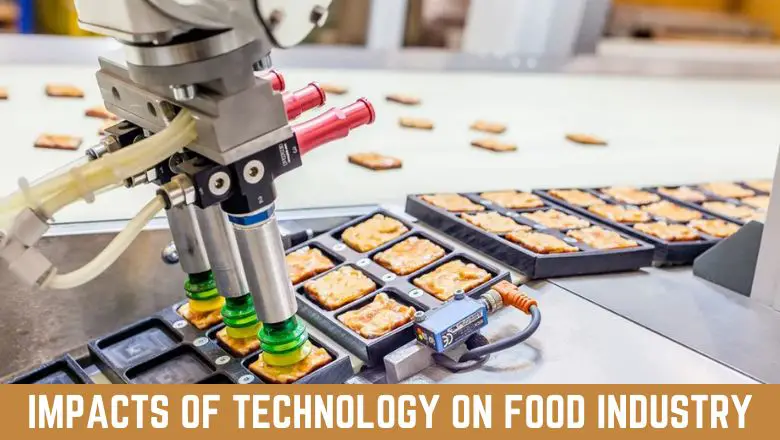In this article, you will get to know all details about “Impacts of Technology on Food Industry“.
The impacts of technology on the food industry have gone extensive. In the 21st century, the food industry has evolved dramatically, and maintaining the long chain of supply and satisfying the human hunger for food has become increasingly complex.
Innovation is necessary to maintain the processes in the food industry since food is one of the most important and beloved obligations of life.
As part of a healthy lifestyle and normal growth, it is essential. In 2025, the food sector will surpass $3.1 trillion due to the love humans have for food.
The purpose of this article is to share some interesting positive effects of technology on the food industry.
Positive Impacts of Technology On the Food Industry:
In every aspect of our lives, technology is providing convenience and aid. Human beings benefit from conveniences related to food.
In all aspects of food production, processing, packaging, and safety, technology is playing a role.
We can incorporate all the technological processes that help us provide food for our stomachs into the positive impacts of technology.
Here are some interesting benefits of technology in bringing food to people.
Increased food production:
In the production of food, technology plays a crucial role. Currently, there are 7.5 billion people in the world, and this number is expected to increase. Such a large population presents a huge challenge.
In order to combat hunger, technology is helping us produce more food. Agricultural technology incorporates digital and advanced technologies into the production of food and raw materials for industrial use and eating in restaurants.
The following are some agriculture-based technology approaches in food production:
GMO’s:
- Genetically modified organisms are known as GMOs. These organisms are created by inserting desired genes into plants.
- To avoid yield losses, GMOs played a significant role in high production and disease resistance.
- Furthermore, they are made to grow in regions with unfavorable environmental conditions, so as to support the demand for food in every region of the world.
- There are a number of major crops that are genetically modified, including wheat, corn, and rice.
Drones:
- Throughout the world, drones are finding applications in a variety of sectors, including food production.
- Through drone cameras, precision agriculture utilizes drones and satellite imagery from above.
- By monitoring crop growth, it is possible to avoid losses and maximize food production by dealing with problem areas effectively.
Technology in the meat industry:
- In high poultry production, artificial intelligence is effective. Because meat and eggs are used in other food industries as raw materials, there is a high global demand for them.
- Artificial intelligence is used to detect health issues in birds based on the sound they make.
- Further, AI robots are used to perform various tasks on poultry farms and butcheries to maintain a rapid pace of production.
- In butchery and meat cutting, robots and machines are performing difficult tasks.
Improved food Storage:
One of the major positive impacts of technology on the food industry is that it has enabled the food industry to safely store food for longer periods after production.
In order to store food products, companies have developed large storage facilities. There is a prescribed environment of cooling or warmth with a good level of nitrogen and oxygen in the storage area.
A storage facility is installed on a transport vehicle to store and transfer food commodities with the required levels of chemicals, moisture, and air.
In storage facilities, oxygen absorbers are used to prevent fruits, vegetables, and meat from rotting and insect infestations.
The facility of the 3D food printer:
A 3D food printer is another fascinating piece of technology in the food industry. An inkjet printer can print mouth-watering food items like candies and pizza with multiple layers and toppings.
Based on the design fed to the software, artificial intelligence designs the structure and layers of food.
A food printer is being designed for homes and restaurants that will make tasty food at a much faster pace than humans can.
The device can make candies in seconds and delicious pizza in just a few minutes. The technology can also be applied to the manufacturing of foods such as cakes, candies, and snacks.
Food packaging:
Food packaging is one of the greatest impacts of technology on food. In the food industry, it is the most important and basic component. The food industry has been revolutionized by the technology of food packaging.
As a result of packaging, food is protected from physical contamination and is delivered to consumers in a safe manner.
Depending on the food item and its characteristics, the packaging is designed. Food items are packaged differently depending on their type.
Tetra packaging is used for dairy products to ensure delivery and shelf life, whereas tins or glasses with a specific amount of oxygen, carbon dioxide, and nitrogen are used for beverages to protect, increase shelf life, and maintain quality.
Accountability of food:
The Internet has made it possible for customers to access the latest and most scientific information regarding food.
A manufacturer cannot mislead customers about food products since they have access to the latest information.
Consumers are well informed about the ingredients and processes of foods.
With this technology, customers can inquire about the ingredients and levels in food from food manufacturers or restaurants.
Food that threatens the customer’s health is avoided by the customer. To satisfy customers and compete in the market, food manufacturers must manufacture healthy and high-quality products.
Promotes a culture of food safety:
One of the positive impacts of technology on the food industry is that technology-enabled scientists are able to conduct in-depth research and discover key facts about food. A special department has been formed to perform research and raise awareness about the foods.
It is possible to harm your health by consuming too much fruit and vegetables because they contain natural toxins.
Furthermore, researchers have discovered that certain foods can have harmful effects on the stomach’s processes. In food items, natural toxins can be identified through technology and scientific processes.
Culture of food safety awareness of consumers to avoid excess consumption of food items and recommend a daily or weekly amount for health safety.
Micro-nutrient food fortification:
Technological advancements and research in the 21st century made people aware of the importance of micronutrients in food.
According to studies, certain diseases and weaknesses are caused due to a lack of micronutrients in certain regions of the world, such as goiter due to iodine deficiency, and scurvy due to vitamin C deficiency.
Whether naturally occurring or not, food fortification enriches foods with needed micronutrients.
The fortification of iodized salt, wheat, and cornflour is available commercially to overcome nutrient deficiencies.
Conclusion:
Food technology has the potential to meet the demands of an exploding population. As a result, we will be able to produce and consume food in a much more efficient manner. The impact of technology on the fast-food industry is soaring.
After realizing the benefits of modern technology, restaurants and food manufacturers have adapted to it.
There will be a revolution in kitchen appliances with the introduction of the 3D food printer in every home. Food of excellent taste can be prepared in a matter of minutes without any inconvenience.
Developing such interesting food technology can not only meet consumers’ demands, but also ensure safety, taste, and long shelf life.
I would appreciate your feedback. Feel free to use the comment section if you have any questions. I will respond as soon as possible.
Do share this article “Impacts of Technology on Food Industry” with your friends. Keep reading and learning with Rehmat Ullah.

